
Dyed Hair Care Secrets
Hair color doesn’t just simply wash out in the shower – your daily habits have a big impact on how long hair color lasts. Water that’s too hot, abrasive shampoo, constant blow-drying, and skipping heat protection can nibble away at the shine and color day after day. The good news: lasting color isn’t luck — it’s the result of the right care. In this guide, you’ll find seven proven rules, mini rituals, and checklists from our team of colorists, care technologists, and a trichologist. It’s concise, practical, and packed with actionable steps.
What you’ll learn:
- Why the first 48 hours after coloring make all the difference
- How to wash your hair so your color doesn’t rinse away
- How to balance “moisture–protein” for dense, glossy hair
- Styling without compromise: heat, tools, and smart hacks
- Protection for sun, pool, and gym days
- Between-color freshness: how to keep that mirror shine until your next visit
- A weekly care plan + an in-shower checklist
Tip 1. The 48-Hour Rule: let the color “set”
Why are the first two days so decisive?
After coloring, the hair cuticle stays slightly open, allowing pigment to remain vulnerable. It takes time for the cuticle to close and the color to fully set. During this period, oxidative polymerization occurs — dye molecules bond and stabilize within the hair shaft.
Any stress on the hair like steam, very hot water, harsh surfactants, or oils, can disrupt this process and cause the color to fade more quickly.
What to avoid for the first 48 hours:
- hot water and a blow-dryer/flat iron on max;
- pool, bathhouse, sauna;
- strong shampoos (including volumizing/deep-cleansing);
- oils and heavy serums along the lengths – they can shift fresh pigment.
At this stage, less is more. Give your hair a moment to settle and stabilize.
Exception: direct dyes and toning
If the coloring used direct pigments (no ammonia), they mostly sit on the surface. A co-wash or conditioner is acceptable after 24 hours to remove residual dye from the scalp. No scrubbing, and skip “deep-cleansing” formulas.
Mini shine ritual
After 48 hours, book a Kevin Murphy Express Glossing: it seals the cuticle, boosts light reflection, and visually deepens the color. Within 20–30 minutes, your hair regains that freshly colored glow.
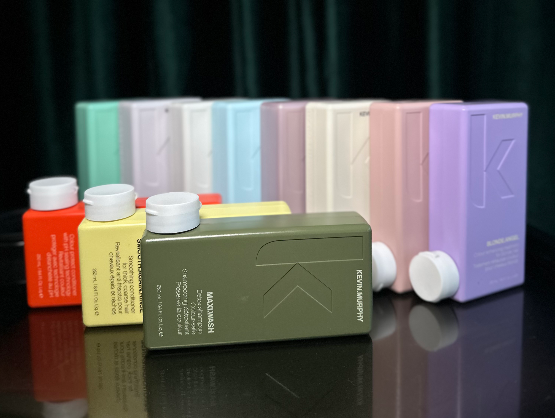
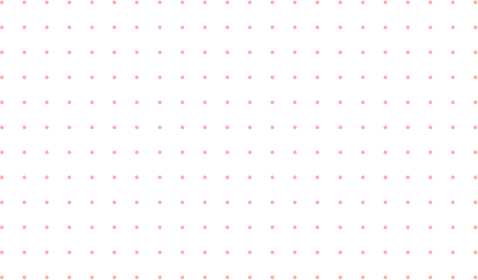
Tip 2. Smart washing: how, with what, and how often
Frequency
2–3 washes a week is the sweet spot: clean scalp without speeding color fade. Between washes, use a powder dry shampoo (look for gentle, non-aggressive absorbers). Apply along partings, wait 1–2 minutes, then gently fluff the roots — don’t rub the ends.
Exceptions: after intense workouts or heavy styling, do a minimal wash: wet only the roots with warm water, apply a small amount of shampoo to the scalp, rinse thoroughly, and avoid touching the lengths.
Technique — step by step
- Water temperature: warm — about 37–38°C. Hot water opens the cuticle and accelerates pigment loss.
- Double shampoo on the scalp:
- 1st pass: dissolve sebum and product — massage with fingertips for 40–60 seconds, then rinse.
- 2nd pass: cleanse and gently stimulate the scalp for 60–90 seconds; pay attention to the hairline and nape.
- 1st pass: dissolve sebum and product — massage with fingertips for 40–60 seconds, then rinse.
- Be gentle with the lengths: don’t rub the mid-lengths and ends. Use the foam from the roots and gently draw it through the mid-lengths and ends for the final 10–15 seconds to avoid stripping tone.
- Re-lather before the final rinse: add a little water, massage the scalp briefly, then rinse — this helps bind and remove impurities more evenly.
- Finish with a cool rinse: 30–45 seconds of cooler water helps the cuticle lie flat.
- Conditioner or mask: apply only to the lengths (leave 3–5 cm away from the roots). Follow the product timing; before rinsing, add a little water and emulsify to distribute evenly.
Pro tips:
- Use lines for colored hair with pH 4.5–5.5. A slightly acidic environment helps “close” the cuticle.
- Hard water oxidizes pigment – hair looks duller. A shower filter is baseline. Also add a chelating/metal-detox treatment every 2–4 weeks to remove mineral and metal ion buildup. After chelation, always rebalance pH (acidic conditioner/mask).
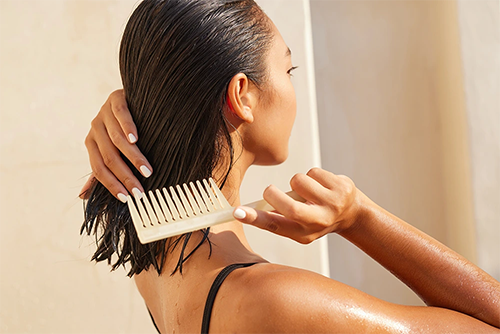

For lightened hair:
- Use ultra-gentle formulas and boost moisture with ingredients like betaine, panthenol, allantoin, or silk/rice amino acids.
- Purple or blue shampoos work as a corrective treatment once every 1–2 weeks, not at every wash, to avoid gray buildup or overly cool tones.
- Apply reparative masks with lipids (ceramides, cholesterol, free fatty acids) once a week in a thin layer — don’t overdo it.
- Heat protection is essential: blonde hair loses moisture faster, and heat damages both pigment and shine.
Scalp detox and oil-control without stripping color – ORising trichology protocols.
Seboregulators work on the scalp without lifting color from the lengths.
Result: less need for frequent washing; your color stays vivid longer.
Tip 3. Protein–moisture balance: masks that actually work
Beautiful color is not just pigment, it’s structure. If hair is dry, brittle, or feels “rubbery,” no tinted balm will save it. Everything hinges on balancing two pillars: moisture and protein.
How to tell what’s missing:
Moisture deficit
Hair looks dull, stiff, staticky; ends stick out. After washing it dries quickly but looks “straw-like.” You need a hydrating mask: hyaluronic acid, aloe, glycerin, panthenol, betaine, oils in micro-doses.
Protein deficit (keratins, amino acids)
Hair stretches like a rubber band and snaps easily while brushing. After lightening it feels “gummy” and shapeless. You need a reparative/protein mask to fill structural voids.
Protein overload
Hair suddenly turns dull, brittle, and “wooden.” That signals an over-saturated protein structure – time to pause and switch to gentle hydration.
The balance is ideal when hair is smooth, elastic, and dense, styles easily, and shines even without styling.
Care schedule
- Hydrating mask – once a week.
- Protein or complex reparative – every 10–14 days.
- For lightened/blonde hair – more often as indicated if there’s breakage or “gummyness.”
Alternation matters: protein without moisture makes hair brittle; moisture without protein makes it overly soft.
Application hack — salon-style
- After shampooing, gently squeeze excess water from your hair with a towel — don’t twist.
- Section hair into 2–3 cm panels.
- Apply the mask through the lengths, keeping it 5 cm away from the roots.
- Distribute evenly with a wide-tooth comb.
- Let it process exactly as directed (5–15 minutes, depending on the formula).
- Before rinsing, add a little water and emulsify to create a uniform consistency — this improves absorption.
- Rinse with cool water.
Bonus tip: if you have time, wear a cap and gently warm with a hair dryer — heat helps the mask penetrate deeper.
Leave-ins: your daily “insurance”
After your main wash, use a leave-in conditioner or cream spray + heat protectant.
They create a micro-thin film that:
- locks in moisture;
- reduces friction while detangling;
- buffers dry air, UV, and dryer heat;
- protects pigment from photofade.
Formulas with amino acids, keratin, niacinamide, camellia oil, or silk proteins work best.
TOKIO Inkarami Deep Repair
This treatment rebuilds hair from within. Keratins and polymers integrate into the structure, making strands elastic and glossy.
Ideal after coloring and lightening – hair feels denser, more obedient, and visually “richer.”
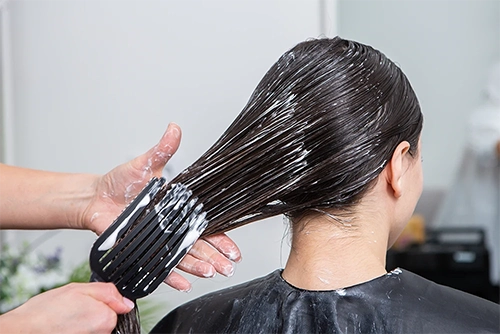

Tip 4. Heat zen: styling without sacrificing color
Before a blow-dryer, curling iron, or flat iron – always use heat protectant, even if you’re “just air-drying a bit.”
When heated above ~150 °C, water inside the hair turns to steam; without a protective film the cuticle literally blisters from the inside. The result: porosity, breakage, and a faded tone.
What to choose:
- sprays and creams with polymers and amino acids (Dimethicone, Hydrolyzed Keratin, Silk Protein, Polyquaternium-55, etc.);
- match the format to your tool: spray → blow-drying, cream → flat iron/curling iron;
- apply to damp hair, distribute with a comb, don’t over-apply – excess “bakes on” and kills shine.
Blow-dryer: how to dry without harming color
- Always use a concentrator nozzle — it directs airflow and protects the lengths from scattered heat.
- Keep the dryer 15–20 cm away from your hair.
- Start with warm air, then finish with a cool shot to smooth the cuticle.
- Don’t dry completely: leaving a bit of internal moisture (2–3%) helps retain hydration and maintain natural shine.
Tools & Temperature
- For colored and lightened hair, keep styling tools at a maximum of 180–185 °C.
- Don’t linger on a strand — 1–2 seconds per pass is enough. Multiple gentle passes are better than one intense hold.
- Irons with floating plates and ionization help reduce friction and static, protecting hair and preserving color.
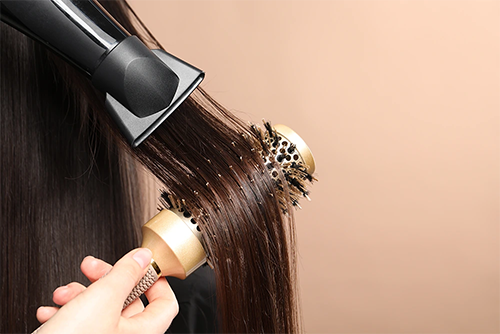

Don’t forget to clean your tools
Residue from styling products, silicones, and dust burns onto plates when heated and redeposits on hair, stealing shine.
Wipe plates with an alcohol wipe weekly and clean the dryer filter.
ProAddiction
A restorative-smoothing service that makes hair more manageable and even, reduces frizz, and simplifies at-home blow-drying. Your hair looks tidy without the need for a flat iron.
Tip 5. Sun, pool, and sports: protection on the go
Ultraviolet: the enemy of shine and pigment
Sunlight isn’t just warmth, it’s oxidative stress. Under UV, color “bleaches,” the cuticle loosens, and hair loses moisture – especially blondes and coppers.
What to do:
- Before going out, use a spray or milk with UV filters (Octocrylene, Benzophenone, Ethylhexyl Methoxycinnamate, etc.). They form a thin, light-diffusing film.
- Reapply every 2–3 hours or after swimming.
- Braids or a low bun fade less.
- The ideal duo is a hat, bucket hat, or bandana + UV protection. Filters shield pigment; fabric protects the cuticle from overheating.
Pool and sea: double protection
Chlorine and sea salt are strong oxidizers. They draw out pigment and moisture, and heat from the sun amplifies damage.
Before swimming:
- Saturate hair with fresh water – like “filling a sponge”: the more inside already, the less chlorine/salt can enter.
- Apply a conditioner or barrier oil to create a protective film. Lightweight silicones or natural esters (castor, coconut, jojoba) work well.
- For long swims, secure hair in a bun or braid, and use a silicone swim cap if possible – even partial coverage saves color.
After swimming:
- Rinse immediately with fresh water to remove salt and chlorine.
- At home – use a gentle shampoo with antioxidants (vitamin E, green tea, algae extract).
- Apply a reparative mask to restore elasticity and neutralize chemical stress.
Important: don’t comb wet, salty hair without conditioner – salt crystals shred the fibers.
Sports and an active pace: protection from salt stress
Sweat disrupts the scalp’s salt and acid balance. Roots get oily while lengths dry out.
Post-workout:
- If there’s no time for a full wash, quickly rinse with warm water to remove salt.
- Apply an express conditioner or leave-in to rebalance pH and calm static.
- For regular training under a helmet or in heat – light sprays with niacinamide or green tea extract help regulate perspiration.
Hack: carry a travel-size gentle co-wash and a microfiber mini towel – rescue your hair in the locker room without a dryer.
Kevin Murphy Summer Protocol (UV + anti-salt + shine)
We tailor the formula to your hair type and assemble a travel kit for vacation.
These products neutralize salt and chlorine, boost shine, and shield pigment even under intense sun.


Tip 6. Between-service fresh: extend your shade’s life
To preserve depth and shine until your next visit, support your color between services – gently but regularly.
Glossing and toning between color appointments
After 3–6 weeks, pigment washes out and cuticle scales lift without extra care. Glossing – a light toning – helps:
- restores shine and color clarity;
- refreshes undertone without ammonia;
- levels porosity and closes the cuticle.
Frequency:
- Light shades, decolorized hair – every 3–4 weeks.
- Natural and dark shades – every 5–6 weeks, at the first signs of dullness.
Tip: if you want to keep that “salon gloss” longer, choose formulas with a ceramide or acid complex – they don’t just color, they seal the surface.
Tinted masks and shampoos: a fine line
These help neutralize brassiness, revive blonde, or intensify cool/warm undertones.
But it’s easy to “overfeed” the color – drifting into grayness, dullness, or excessive density.
How to use wisely:
- No more than once a week.
- Apply to damp hair and control timing (2–5 minutes, no longer).
- Always follow a tinted shampoo with a gentle hydrating mask to restore elasticity.
- For blondes and pastels – alternate a tinted mask with a neutral care mask to avoid pigment buildup.
Hack: want a subtle refresh without darkening? Mix a drop of tint into your regular mask and distribute evenly with a comb.
Micro-trims: a visual color upgrade
Even the most durable pigment looks dull on split ends – fractured tips don’t reflect light and make color look uneven.
A trim every 6–8 weeks visually renews the shade and keeps the lengths looking dense and groomed.
It’s not “losing length” – it’s investing in your color quality.
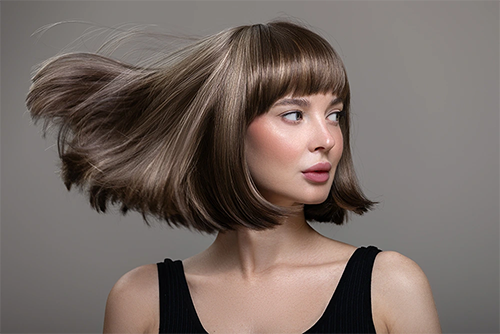

At-home “anti-fade” care
Between visits, don’t just cleanse – slow color loss.
Look for series labeled “color safe” or “anti-fade” with:
- mild, sulfate-free surfactants;
- antioxidants (vitamin E, sunflower seed, green tea);
- UV filters;
- acidic pH (4.0–5.5) to keep the cuticle closed.
Tip: with the right routine, hair stays glossy – no “dusty” cast – even a month after coloring.
Express toning + TOKIO Inkarami
In 45–60 minutes you get a fresh shade and deep repair in one go.
Keratin polymers strengthen the structure while toning restores shine and clarity.
Tip 7. Autopilot routine: a weekly care plan
The most reliable way to keep flawless color and shine is consistency. Hair responds steadily: less frizz, fewer breaks, and that “first-days-after-color” look stays longer.
Monday: gentle cleanse and reset the baseline
- Shampoo: mild, neutral pH, sulfate-free – removes buildup without stripping the protective film.
- Conditioner: for colored hair – with rice or shea oils, silk proteins, or hydrolyzed keratin.
- Leave-in: a light cream or spray to lock in moisture and shield from heat, constant friction, and UV.
Tip: towel-blot, apply leave-in, and detangle with a wide-tooth comb for even distribution.
Wednesday: co-wash or delicate cleanse
A “reset” day without extra stress on color.
- Swap shampoo for a co-wash (cleansing conditioner) or a gentle cleansing cream – removes sebum but preserves hydration.
- Follow with a hydrating leave-in emulsion or spray with panthenol, betaine, amino acids.
- If you’re prone to oiliness – add a light scalp spray with niacinamide at the roots.
Why it matters: the scalp breathes while pigment is spared harsher detergents.
Saturday: repair & relax
- Shampoo: delicate, without harsh surfactants, labeled “Color Safe” or “Gentle Cleanse.” The goal isn’t a squeaky feel—it’s simply removing sebum and styling so mask actives absorb evenly.
- Mask: choose for your hair’s state.
- Dry, dull — hydrating (aloe, hyaluronic acid, betaine).
- Fragile, damaged — protein (keratin, amino acids, ceramides).
- After the mask, cool-rinse to seal the cuticle.
- If possible, air-dry or use the dryer on minimum.
Tip: skip the flat iron today – let hair rest and rebuild internal bonds.
Every day: small habits that change everything
- Heat protectant before any styling – even just a blow-dry.
- A silk pillowcase reduces friction, minimizes static, preserves style and shine.
- Gentle detangling: always from ends to roots. On damp hair – only a wide-tooth comb or a nylon/boar bristle brush.
- Mini breaks between heat stylings: give hair a no-heat day.
Don’t want to guess what to use when?
We’ll curate a personalized Kevin Murphy/ORising set for your color type – with a day-by-day schedule.
Your kit will include products for cleansing, repair, color protection, and shine – with a detailed usage plan.
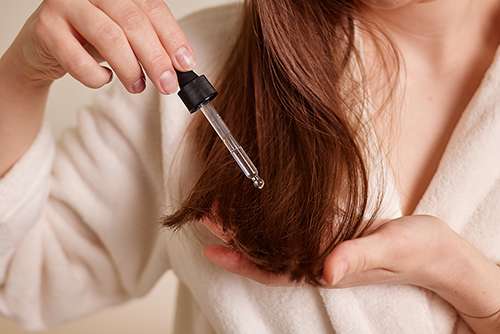

Common mistakes and how to avoid them
Mistake #1
Washing too often with hot water
What happens: warm water opens the cuticle; hot water practically “flushes out” pigment and the lipid film. Color loses depth, blondes yellow, dark shades go flat.
How to avoid:
- wash 2–3 times a week with warm (not hot) water ~37–38 °C;
- finish with a cool rinse – it seals the cuticle and boosts shine.
Tip: want freshness between washes? Dry shampoo or co-wash preserves both volume and color.
Mistake #2
“Super-nourishing” oils in the first 48 hours
What happens: right after coloring the cuticle is still open. Oil applied now can “soften” pigment, cause migration, or muddy the shade.
How to avoid:
- skip oils, serums, and heavy creams for the first two days;
- if you need smoothing – choose a light leave-in spray with amino acids + heat protection;
- bring oils back after 48 hours – once the color stabilizes.
Mistake #3
High-heat styling without protectant
What happens: above ~180 °C, pigment degrades and the cuticle “melts.” The outcome – faded tone, breakage, and lost shine.
How to avoid:
- heat protectant, always – even for a quick blow-dry;
- flat iron at ≤180–185 °C, dryer on medium;
- don’t park the tool on one section; don’t over-dry.
Mistake #4
Hard water without protection
What happens: calcium and magnesium salts deposit on hair, make it “squeaky,” rob shine, and lead to dullness, breakage, and uneven color.
How to avoid:
- install a shower filter or use a chelating (metal detox) treatment every 2–4 weeks;
- after contact with chlorinated or salt water – rinse with filtered or bottled water;
- use acidic conditioners (pH 4.0–5.0) to neutralize mineral deposits.
Mistake #5
Random “strong” shampoos
What happens: deep-cleansing, volumizing, or dandruff shampoos often contain harsh surfactants that strip pigment in a single wash.
How to avoid:
- choose formulas labeled Color Safe, Anti-Fade, or Gentle Cleanse;
- if you need volume – use a root spray or powder, not an aggressive shampoo;
- keep a deep-cleanse shampoo only for rare SOS moments – no more than once a month.
FAQ
Ideally after 48 hours, so the cuticle closes and pigment sets inside the hair.
Use purple shampoos or masks every 1–2 washes, heat protectant for every styling session, and anti–hard-water care – it neutralizes mineral salts that cause brassiness.
Yes, but with protection: before swimming apply a conditioner or barrier oil, wear a cap, and afterwards use a gentle cleanser and a hydrating mask.
Main culprits: frequent hot-water washing, no heat protectant, sun exposure, hard water, and insufficient care.
A combined approach: glossing + TOKIO Inkarami or ProAddiction for structural repair, plus ORising trichological detox for a clean scalp and even shine through the lengths.

